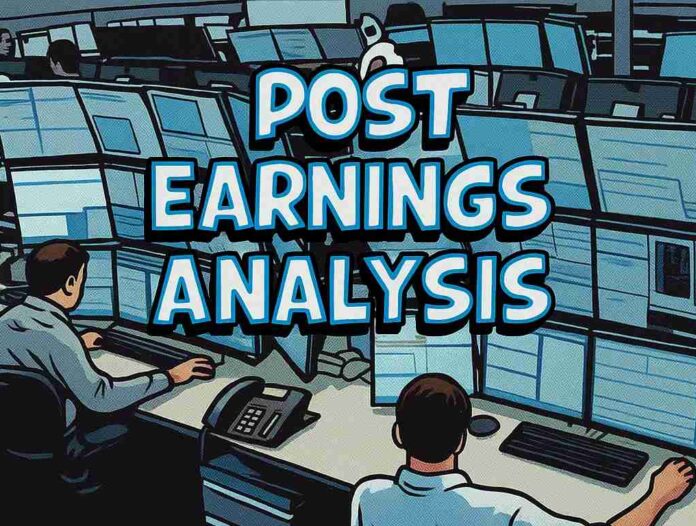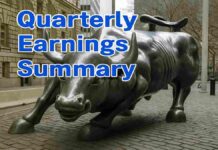Conagra Brands Inc. (CAG) Post Earning Analysis
Conagra Brands, Inc., founded in 1919 and headquartered in Chicago, Illinois, specializes in the manufacture and sale of processed and packaged foods. The company operates through four main segments: Grocery and Snacks, Refrigerated and Frozen, International, and Foodservice. These segments cater to a variety of retail and foodservice channels, offering a range of food products both domestically and internationally.
Recent news surrounding Conagra Brands (CAG) indicates a mixed financial landscape that could influence its stock performance. On October 1, 2025, Conagra reported first-quarter earnings which exceeded expectations, despite a 5.8% year-over-year decline in sales, as noted by Zacks and several other sources. This earnings beat led to a positive surge in the stock price, as highlighted by Motley Fool and Investing.com. However, concerns are evident with Evercore ISI cutting Conagra’s price target to $23 due to commodity inflation pressures, signaling potential challenges ahead.
Additionally, Conagra’s dividend policy has been identified as appealing to long-term investors, potentially providing a buffer against market volatility. Despite the positive earnings report, broader economic factors such as inflation and tariffs are adding pressure, with Conagra reaffirming its outlook amidst these challenges. The overall sentiment appears cautiously optimistic, with the company’s ability to navigate inflationary pressures being a critical factor for future stock performance.
The current price of $19.10 represents a significant decline from both the 52-week and year-to-date (YTD) highs of $31.04 and $27.6, respectively, showing a decrease of approximately 38.45% from the 52-week high and 30.78% from the YTD high. This indicates a bearish trend over the longer term. However, the price has shown some resilience compared to the 52-week and YTD lows of $17.89, with current levels being about 6.79% higher, suggesting some recovery or stabilization in the shorter term.
The moving averages further highlight this trend, with the price currently above the 20-day and 50-day moving averages by 1.62% and 0.84%, respectively, but still significantly below the 200-day moving average by 14.85%. This discrepancy indicates potential short-term recovery amidst a prevailing long-term downward trend.
The Relative Strength Index (RSI) at 54.18 suggests the stock is neither overbought nor oversold, providing a neutral market sentiment signal. Meanwhile, the Moving Average Convergence Divergence (MACD) being slightly negative (-0.13) hints at a bearish momentum but not strongly so, aligning with the short-term recovery indicated by the moving averages.
Overall, the stock shows signs of short-term stabilization following a longer-term downtrend, with mixed signals from RSI and MACD hinting at cautious optimism for potential slight upward corrections. However, the significant underperformance relative to the 200-day moving average and high peaks indicates that any bullish trends need to be viewed with caution.
Price Chart

Conagra Brands, Inc. (NYSE: CAG) has released its financial results for the first quarter of fiscal year 2026, revealing a downturn in several key financial metrics. The company reported a decrease in net sales by 5.8% to $2.6 billion, with organic net sales also down by 0.6%. This decline was attributed to a 1.2% decrease in volume, despite a slight positive impact from price/mix adjustments of 0.6%.
Operating margins suffered as well, with reported operating margin falling to 13.2%, a decrease of 118 basis points. Adjusted operating margins saw a more significant drop of 244 basis points to 11.8%. In terms of profitability, Conagra reported a sharp decrease in earnings per share (EPS), with reported diluted EPS down 64.9% to $0.34, and adjusted EPS decreasing by 26.4% to $0.39.
The company also experienced a substantial decrease in net income, which declined by 64.8% to $165 million. Adjusted net income fell by 25.1% to $189 million. Additionally, net cash flows from operating activities were down by 55.1% to $121 million, and free cash flow turned negative to $(26) million, a stark contrast to the previous year’s $135.6 million.
Despite these challenges, Conagra reaffirmed its fiscal 2026 guidance, expecting organic net sales growth between -1% and 1%, an adjusted operating margin of approximately 11.0% to 11.5%, and adjusted EPS ranging from $1.70 to $1.85. The company also declared a quarterly dividend of $0.35 per share and reported $15 million in share repurchases during the quarter.
Earnings Trend Table
| Date | Estimate EPS | Reported EPS | Surprise % | |
|---|---|---|---|---|
| 0 | 2025-10-01 | 0.33 | 0.39 | 18.18 |
| 1 | 2025-04-03 | 0.53 | 0.51 | -3.34 |
| 2 | 2024-12-19 | 0.67 | 0.70 | 3.77 |
| 3 | 2024-10-02 | 0.60 | 0.53 | -10.95 |
| 4 | 2024-07-11 | 0.57 | 0.61 | 6.52 |
| 5 | 2024-04-04 | 0.65 | 0.69 | 5.52 |
| 6 | 2024-01-04 | 0.68 | 0.71 | 4.51 |
| 7 | 2023-10-05 | 0.60 | 0.66 | 10.38 |
Over the past eight quarters, the company has demonstrated a generally positive trend in earnings per share (EPS), with reported EPS frequently surpassing the estimated values. Notably, in five out of the eight quarters analyzed, the company exceeded analyst expectations, with the surprise percentage ranging from 3.77% to 18.18%. The most substantial positive surprise occurred in Q4 of 2025, where the reported EPS of 0.39 exceeded estimates by 18.18%.
However, there have been instances of earnings misses. The most significant negative deviation occurred in Q4 of 2024, where the reported EPS of 0.53 fell short of the estimate by 10.95%. Another miss was observed in Q2 of 2025, with a -3.34% surprise, indicating a slight underperformance relative to expectations.
The fluctuations in EPS surprises suggest variability in either the company’s operational performance or the accuracy of analyst estimates across different periods. Despite these variations, the overall positive surprises indicate a robust capacity to outperform expectations, which could be a favorable indicator for investors assessing the company’s financial health and operational efficiency.
Dividend Payments Table
| Date | Dividend |
|---|---|
| 2025-07-30 | 0.35 |
| 2025-04-28 | 0.35 |
| 2025-01-27 | 0.35 |
| 2024-10-31 | 0.35 |
| 2024-08-01 | 0.35 |
| 2024-04-29 | 0.35 |
| 2024-01-29 | 0.35 |
| 2023-11-01 | 0.35 |
Reviewing the dividend data from the last eight recorded instances, it is evident that there has been a consistent dividend payout of $0.35 per share. This steady pattern, observed from November 2023 through to July 2025, suggests a stable dividend policy by the company. The uniformity in dividend payments over this period indicates a solid financial management strategy aimed at maintaining investor confidence and providing predictable returns to shareholders. The lack of variation in the dividend amount also suggests that the company’s earnings and cash flow positions are stable, enabling it to sustain ongoing dividend payments at this rate. This consistency is crucial for income-focused investors who rely on dividends for a portion of their investment returns. Overall, the data portrays a company committed to providing regular shareholder returns, reflecting a potentially lower-risk investment profile in terms of dividend reliability.
The four most recent ratings changes for the stock in question reflect a mix of neutral stances and negative outlooks from major financial institutions.
-
JP Morgan (Resumed, Neutral, $20, August 20, 2025): JP Morgan resumed coverage of the stock with a “Neutral” rating and a target price of $20. This suggests that JP Morgan analysts see the stock performing in line with the broader market or sector, without significant upside or downside potential.
-
UBS (Initiated, Neutral, $22, June 16, 2025): UBS initiated coverage with a “Neutral” rating and a target price of $22. This initiation slightly above JP Morgan’s assessment indicates a cautiously optimistic view but still aligns with a general market performance expectation.
-
BofA Securities (Downgrade, Neutral → Underperform, $20, June 12, 2025): BofA Securities downgraded the stock from “Neutral” to “Underperform” with a target price of $20. This change reflects a shift from a neutral outlook to a negative stance, suggesting that BofA Securities expects the stock to underperform relative to the market or its sector peers.
-
Goldman Sachs (Downgrade, Neutral → Sell, $21, June 9, 2025): Close to BofA’s assessment, Goldman Sachs downgraded the stock from “Neutral” to “Sell” with a slightly higher target price of $21. This rating indicates a stronger conviction that the stock will decline in value, advising investors to potentially divest their holdings.
Overall, these recent ratings indicate a cooling sentiment towards the stock, with two downgrades to less favorable positions and two neutral stances, suggesting a cautious or negative outlook in the near term.
The current price of the stock is $19.10, which is below the average target price suggested by major analysts. The target prices range from $20 to $22, with an average of approximately $20.75, indicating a potential upside of about 8.7% from the current level.
Recent analyst actions include a resumption by JP Morgan with a neutral rating at a target price of $20, and an initiation by UBS with a neutral rating at $22. However, there have been some negative sentiments as well, with BofA Securities downgrading the stock from neutral to underperform with a target price of $20, and Goldman downgrading it from neutral to sell at a target price of $21.
These mixed ratings and the slight variation in target prices suggest a cautious outlook on the stock, reflecting uncertainty in its performance prospects. The professional consensus leans towards a neutral stance with cautious undertones, primarily due to the recent downgrades.
Disclaimer: The information provided here is for educational and informational purposes only and should not be interpreted as financial advice, investment recommendations, or trading guidance. Markets involve risk, and past performance is not indicative of future results. You should always conduct your own research and consult with a qualified financial advisor before making any investment decisions. By acting, you accept full responsibility for your choices.




